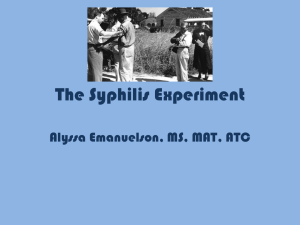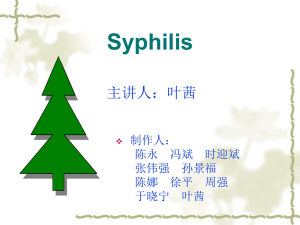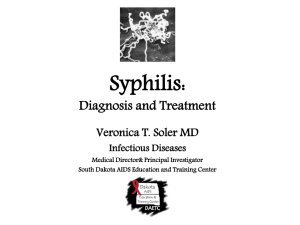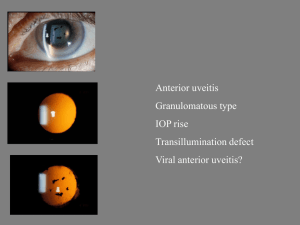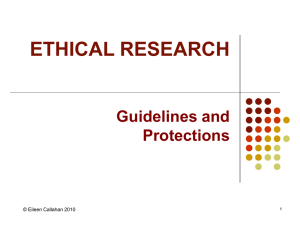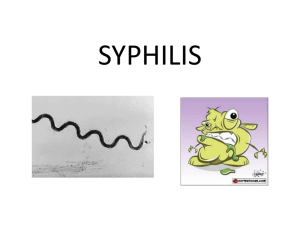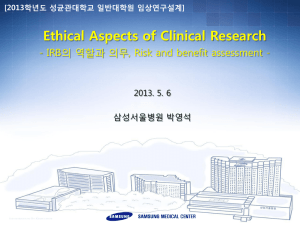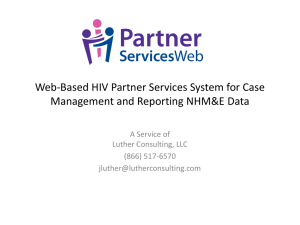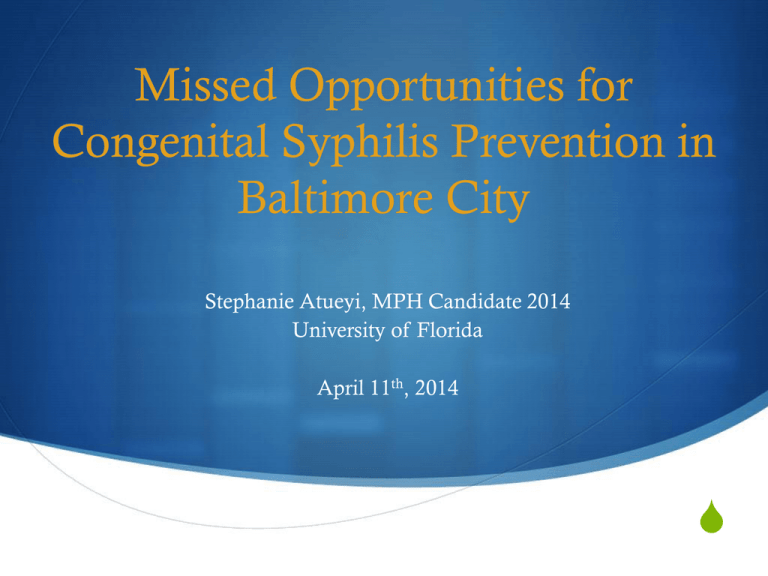
Missed Opportunities for
Congenital Syphilis Prevention in
Baltimore City
Stephanie Atueyi, MPH Candidate 2014
University of Florida
April 11th, 2014
S
Outline
S Introduction
S National congenital syphilis case definition
S Epidemiology of Syphilis
S Syphilis in women
S Congenital syphilis
S Rationale for an assessment
S Review of previous studies
S Study design
S Results and Discussion
S Public Health Competencies
S
Introduction: Syphilis in Pregnancy
S
An infection caused by Treponema
Pallidum
S
Can result in mother-to-child
transmission (congenital syphilis)
S
Major complications
S Preterm births
S Stillbirths
S Bone abnomalities
S
Prevention of congenital syphilis is a
“winnable battle”
Healthy People 2020. Healthypeople.gov. Disparities. [Online] December 29,
2010. [Cited: March 31, 2014.]
Risk Factors
S Risk Factors
S Uninsured
S Living in poverty
S Sex workers
S Illicit drug use
S Or living in communities with high syphilis morbidity
Epidemiology
S There has been a drastic decline in the rate syphilis
S A decline of 95.4% since 1990 for primary and secondary
syphilis in woman
S A decline of 92.4% from 1991 to 2005 for congenital syphilis
S Trends of congenital syphilis tend to follow trends for P&S
syphilis in women
S Rates increased during 2005-2008 period
Centers For Disease Control and Prevention. CDC.gov. Sexually Transmitted
Disease Surveillance 2012. [Online] Center for Disease Control and Prevention,
January 7, 2014. http://www.cdc.gov/std/stats12/default.htm
Reported Cases of Congenital Syphilis Among Infants and Rates
of Primary and Secondary Syphilis Among Women
Centers For Disease Control and Prevention. CDC.gov. Sexually Transmitted
Disease Surveillance 2012. [Online] Center for Disease Control and Prevention,
January 7, 2014. http://www.cdc.gov/std/stats12/default.htm
Epidemiology cont.
The highest rates occur in:
S The southern region of the United States
S Women aged 20 to 24 years
S African Americans
Centers For Disease Control and Prevention. CDC.gov. Sexually Transmitted
Disease Surveillance 2012. [Online] Center for Disease Control and Prevention,
January 7, 2014. http://www.cdc.gov/std/stats12/default.htm
Congenital Syphilis: Rates by of Birth and Mother’s Race/
Ethnicity United States, 2003-2012
Centers For Disease Control and Prevention. CDC.gov. Sexually Transmitted
Disease Surveillance 2012. [Online] Center for Disease Control and Prevention,
January 7, 2014. http://www.cdc.gov/std/stats12/default.htm
National Objectives to Reduce Rates of
Congenital Syphilis
S Healthy People 2020
S reduce congenital syphilis rates to 9.6 new cases per 100,000
live births
S Government Performance and Results Act
S
reduce congenital syphilis rate to 10 cases per 100,000 live
births
Centers For Disease Control and Prevention. CDC.gov. Sexually Transmitted
Disease Surveillance 2012. [Online] Center for Disease Control and Prevention,
January 7, 2014. http://www.cdc.gov/std/stats12/default.htm
Healthy People 2020. Healthypeople.gov. Disparities. [Online] December 29,
2010. [Cited: March 31, 2014.]
Congenital Syphilis in Maryland
S Maryland has one of the highest rates in the US
S second highest rate of congenital syphilis in 2011
S Congenital syphilis rate exceeded 20 cases per 100,000 live births
from 2005 to 2011
S In 2012, the rate decreased to 16 cases per 100,000 live births
S Baltimore City accounted for 50% of congenital syphilis cases in 2012
Centers For Disease Control and Prevention. CDC.gov. Sexually Transmitted
Disease Surveillance 2012. [Online] Center for Disease Control and Prevention,
January 7, 2014. http://www.cdc.gov/std/stats12/default.htm
Screening for Syphilis in Pregnancy
in Maryland
S Screen for syphilis in pregnant women at first prenatal care
visit
S Screen at the beginning of the first trimester (28 weeks)
S Screen at time of child labor and delivery
S Syphilis is a notifiable disease, and should be reported to the
health department within 48 hours
Rationale for Project
S High rates of congenital syphilis cases
S A need to determine:
S Missed opportunities of congenital syphilis prevention
S causes or risk factors
S potential strategies for prevention and reducing risk
Previous Studies
Setting
New York City, NY
Health Department
Method
Retrospective case
review
Timeframe
Jan 2000 to Dec 2009
Missed Opportunities for Preventing
Congenital Syphilis Infection in New
York City. Patel, Sameer J. MD,
MPH, et al., et al. 4, s.l. : Obstetrics
& Gynecology, 2012, Vol. 120. 882888
Marcopa County, AZ
Health Department
Defined Missed
Opportunities
1) No maternal treatment
2) Lack of syphilis
screening
3) Late maternal treatment
4) Inappropriate maternal
treatment **
Women who did not
receive prenatal care were
excluded
Missed Opportunities for Congenital
Syphilis Prevention in an Urban
Southeastern Hospital. WARNER,
LEE MPH, et al., et al. 2, s.l. :
Sexually Transmitted Diseases,
2001, Vol. 28. 92-98.
195 cases were
reported: 29% of
pregnant did not
receive syphilis
screening ; 13%
received delayed
treatment; 11%
women received no
therapy; Overall 63%
of the mothers had a
missed opportunity
Retrospective case
review
Jan 2000 to Dec 2005
n/a
130 cases were
reported ; missed
opportunities found
were lack of prenatal
care; lack of prenatal
screening; and delayed
treatment
retrospective chart
review
July 1990 to Jun 1993
n/a
157 cases identified;
delayed or missed
syphilis screening,
diagnosis, and/or
treatment. Missed
opportunities were
related to number of
prenatal care visits
Opportunities for the Prevention of
Congenital Syphilis in Maricopa
County, Arizona. Taylor,
Melanie M. MD, MPH, et al.,
et al. 4, s.l. : Sexually
Transmitted Diseases, 2008,
Vol. 35. 341-343
Grady Memorial
Hospital in Atlanta, GA
Results
Methods and Study Design
S A retrospective case review
S congenital syphilis cases reported to Baltimore City Health
Department (BCHD)
S January 1st, 2009 to December 31st, 2012
S Maternal and infant data were collected from:
CDC’s congenital syphilis investigation and report form
S BCHD information system
S
S
Sexually transmitted diseases-management (STD-MIS)
S Looked for missed opportunities for congenital syphilis
prevention
Missed Opportunities
S In women who received prenatal care, there was a missed
opportunity for prevention if there was:
S Lack of syphilis screening:
S At the first prenatal visit
S during third trimester
S Or no screening
S Inappropriate maternal treatment
S Late maternal treatment
S No maternal treatment
S Inadequate or no maternal treatment for syphilis diagnosed
before pregnancy
Methods and Study Design
S For every case of congenital syphilis reported to Baltimore
City Health Department, a case worker evaluated
S Reviewed maternal and infant’s records and completed the
CDC’s investigation form
S determined the congenital syphilis case status using CDC case
definitions for presumptive, confirmed, or syphilitic stillbirth
Surveillance Case Definition for
Congenital Syphilis
S Confirmed case
S Use of dark-field microscopy or direct fluorescent antibody
S Presumptive case
S Untreated or inadequately treated mother at the time of
delivery; OR
S An infant with a reactive treponemal test plus signs of syphilis
S Syphilitic stillbirth
S fetal death in untreated or inadequately treated mother at the time of
delivery after a 20-week gestation or a fetus weighing >500g.
Hypothesis
S Mothers did not receive adequate prenatal care, syphilis
screening, or adequate treatment
S Mothers were at high risk for congenital syphilis
Stakeholders
S
STD/HIV Prevention Program
at BCHD
S
Maternal and Infant Care
Program at BCHD
S
Residents of Baltimore City
Results
S 31 cases of congenital syphilis were reported
S 30 presumptive cases
S 1 syphilitic stillbirth
S Majority of cases were reported to the health department
within 24 to 48 hours from date of newborn delivery
S A confirmatory dark-field exam or direct fluorescent
antibody test (DFA) was not performed on any of the cases
of congenital syphilis.
Infant Characteristics
S Race and Ethnicity
S 83% of the cases were African Americans
S 14% were White
S 3% of cases were Asian.
S Median birth-weight was 2950 g (range 1020 to 4120 g)
S Median gestational age was 39 weeks (range 27 to 41 weeks)
S Majority of cases were asymptomatic
Results cont.
S Congenital syphilis rate from 2009 to 2012 in Baltimore
S 85.1 cases per 100,000 live births
S Highest rate of congenital syphilis occurred in 2009
S Rates of congenital syphilis in Maryland and Baltimore City
were higher than the US average.
Reported Cases and Rate of Congenital Syphilis in
Baltimore City and Maryland
Geographical
Area
Baltimore City
Maryland
Cases
2009
13
31
2010
5
22
2011
7
24
2012
6
12
Rates per 100,000 live births
2009
2010
2011
2012
136.8
55.9
78.8
65.9
41.3
29.3
32
16
Maternal Characteristics
S Median maternal age was 26 years old (range 16 to 40 years).
S
Only 3 of the 31 (approximately 10%) women did not have any
prenatal care
S Most common risk factor was drug habit.
S All women that received treatment were reported to have received
an appropriate treatment with a penicillin regimen.
S A dark field or DFA was not conducted on any of the women
because lesions were not present.
Risk Factors
S Illicit drug use had the highest frequency
S Other risk factors that were reported were:
S Inconsistent or no condom use was reported
S multiple sex partners
S exchange of sex for drugs or money
Missed Opportunities
Missed Opportunities
S
90% of the mothers (28 of 31 mothers) received prenatal care
S
96% of the mothers (27 of 28 mothers) who received prenatal care:
S
S
S
first visit more than 30 days prior to date of delivery
S
screened for syphilis screening at there first prenatal visit
S
screened for syphilis during their third trimester
Treatment
S
67% (19 of 28 mothers) received appropriate therapy
S
14% (4 of 28 mothers) received no therapy
S
17% (5 of 28 mothers) received late therapy
Causes of inappropriate response:
S
Reinfection or relapse
S
Incomplete or equivocal response.
Missed Opportunities
S Findings from this special project differ from previous
studies
S Majority of the mothers were screened for syphilis and treated
adequately
S Most common cause for inappropriate response was
reinfection
S Partner services
Partner Services
S Services provided to people with STDs and their partners.
S confidential
S Medical
S Preventative
S Psychosocial services
S usually provided by health departments
S Partners services significantly increased the rate of partners
presenting to care.
Eliminating Health Disparities
S Increased attention and focus on the communities at risk
S Increase access and quality of care
S Support more research to identify effective strategies to
reduce health disparities
Public Health Competencies
S Monitoring health status to identify and solve community health
problems
S Using laws and regulations that protect health and ensure safety
S Identify & understand the historical context of epidemiology,
epidemiologic terminology; study designs & methodology
S Monitor and evaluate programs for their effectiveness and quality
Limitations
S Limited information on whether the mothers stayed care
S Presumptive cases
S Retrospective review
S Syphilis screening in third trimester
Conclusion
S Congenital syphilis rates in Baltimore City are substantially higher
the Maryland and the US
S Majority of the cases did received adequate prenatal care and
treatment
S Reinfection was the common cause for inappropriate serologic
response
S Partner services and methods to eliminate health disparities
should continue to improve
Acknowledgments
S Glen Olthoff
S Carla Latney
S Sarah McKune
S Susan White

